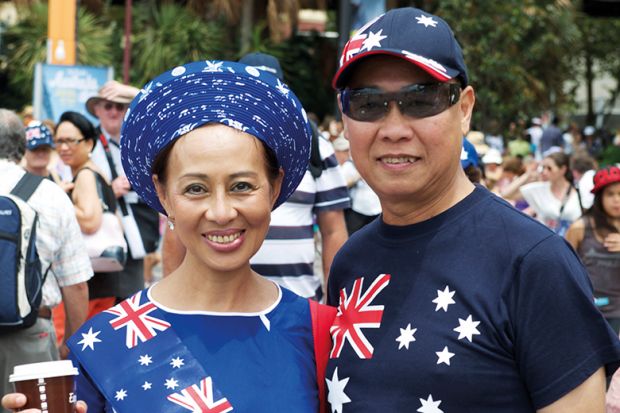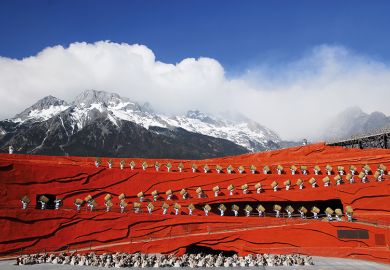Browse the full THE Asia-Pacific University Rankings 2019 results
Australian higher education has held its ground in the latest international league table, with a fast-rising China failing to overwhelm institutions in the Antipodean nation in this year’s Times Higher Education Asia-Pacific University Rankings.
But experts are asking how long Australia can keep it up without making some tough decisions about the breadth of its offerings – in teaching as well as research.
Hamish Coates, professor at Tsinghua University’s Institute of Education, said that the “world-class university virtuous cycle” – which had helped boost the standing of his former employer, the University of Melbourne – was increasingly working for only a select few Australian universities.
“In Australia the topmost research universities have become deeply engaged in using fee revenues from Chinese international students to subsidise their research, which in turn generates prestige or reputation, which then generates fee revenue,” Professor Coates said.
“That virtuous circle works for a very small number of institutions. That’s why they’re doing well – because they’re playing the game, and the game is there to be played by those who can.”
Australia’s improvement in this year’s APAC rankings has been focused on its most elite institutions and a solidly performing middle tier. Among the research-intensive Group of Eight universities, only first-placed Melbourne improved its rank.
Melbourne rose one slot from fourth last year to third, with the next-placed local contenders – Australian National University and the University of Sydney – registering no change at eighth and 11th respectively. The other five Go8 members lost ground.
Ten of the next 14 institutions improved their rankings, with the University of Canberra, Curtin University and Western Sydney University achieving particularly impressive rises. But of the bottom 13 Australian institutions listed, nine slid down the rankings, collectively surrendering more than 100 places.
Melbourne vice-chancellor Duncan Maskell said that Australian universities were facing intense competition from Asia, particularly the generously funded universities of China. “It means Australian universities need to make sure all our energy and resources are directed to our distinctive strengths and the achievement of our strategic goals,” he said.
But some university leaders are asking whether strategic goals are detracting from institutional strengths, in terms of the way that they are assessed in the rankings. “It’s always an issue – do you go for your areas of strength or do you try to compete in other areas?” said Nicholas Fisk, deputy vice-chancellor at the University of New South Wales.
Download a copy of the Asia-Pacific University Rankings 2019 digital supplement
Professor Fisk said that China’s research strengths were concentrated in chemistry and the physical sciences, which respectively accounted for around 44 per cent and 30 per cent of Chinese articles analysed in last year’s Nature Index. Just 15 per cent of its papers were in the life sciences and less than 12 per cent in earth and environmental sciences.
Australia spreads its high-impact publications much more evenly, with life sciences accounting for almost one third of Nature Index publications and the other three broad discipline areas claiming more than 20 per cent each. This breadth is evident at UNSW, which Professor Fisk said had twice claimed bragging rights as the university with the most listings in the ShanghaiRanking subject tables.
“That means we have strengths in engineering, material sciences – areas where the Chinese are doing really well,” he said. “Some people say you should just leave it to the Chinese. Others say, just compete in one or two areas.”
Instead, UNSW is capitalising on Australia’s proximity to China and boosting its home-grown strengths by collaborating through joint appointments and by hosting the first offshore precinct of China’s enormous “Torch” entrepreneurial programme.
Professor Fisk said that occupying almost the same time zone as China, and offering “accessibility without much jet lag”, was a big attraction of Australian academia. He said that UNSW had bagged seven native Chinese speakers among 27 “high-level strategic appointments” of foreign academics since mid-2015. “That makes a big difference in our Chinese collaborations,” he said.
View this year’s Asia-Pacific University Rankings methodology in full
Professor Coates said that another attraction of Australian higher education was that it was “relatively flat”, with parents of overseas students able to trust that their offspring should receive a good education at any of the country’s universities.
But he said that the increasing concentration of foreign students’ fees in a few top institutions was putting that egalitarian structure at risk. “Other institutions are going to start suffering in terms of their research performance,” he predicted.
This also raises the question of whether every university in Australia should be doing research.
“It’s a middle country; it doesn’t have enormous resources; it’s heavily reliant on foreign funds to pay for its top-level research. There may be better ways money can be spent than spreading it thinly across 40-odd institutions," said Professor Coates.
“Japan has made a decision to funnel the funds into a group of elite institutions, and focus them on performing well globally. It’s a lesson that Australia might pick up on. In a way everyone in Australian policy knows that; it’s just hard to bite the bullet and make it happen.”
Griffith University in Queensland is among the improving middle tier of Australian universities, rising one slot to 42nd in this year’s APAC rankings. Tony Sheil, chief of staff to Griffith’s vice-chancellor, said that the breadth of offerings at Australian universities disadvantaged it in teaching metrics.
He said that the science, technology and engineering subjects in which China specialised tended to have relatively low student-to-staff ratios, which gave them a rankings boost. In contrast, Australian universities were “more skewed” toward commerce, management, business, economics, social sciences, arts and humanities.
“There’s a range of disciplines at Griffith that wouldn’t normally be taught in many Asian universities,” he said, adding that courses in music, art and film were the “jewel in the crown” of Griffith’s curriculum. “There’s higher student-to-staff ratios and less resourcing per student, because it’s cheaper to teach law than medicine. The discipline orientation of Australian universities gives the appearance of less teaching performance, according to how it’s measured.”
Mr Sheil said that “the surest way for a university like Griffith to increase overnight in the rankings would be to close down the humanities, arts and social sciences” - something Griffith would “never contemplate” but “potentially would be the strategy in some other countries”.
He added that there were few options for Australian universities to “push the funding envelope”, with both domestic and international enrolments “close to saturation point”. While industry engagement and philanthropy both offered opportunities to boost revenue, neither promised “the sort of heyday when we saw demand-driven domestic funding and massive expansion in international student recruitment”.
“Those options have dried up for Australia. You’re led to the conclusion that we’ll probably plateau soon, and this is as good as it gets. We might reflect on this period and say, ‘do we need to get smaller in order to get better?’ The rankings suggest that we trim down a bit,” he said, adding that such a trend was already evident in the rise of teaching-focused staff in Australia.
Adelaide-based Flinders University is another APAC rankings success story, rising four places to 43rd this year on the back of a 17-place surge last year. Critics allege that the university’s current restructure, which includes the appointment of specialist staff in both teaching and research, is designed to artificially boost its rankings performance and help meet its aim of being among the top 1 per cent of universities globally.
Flinders emphatically rejects this, saying that its rankings improvement predated the restructure and that the employment basis of its specialist staff – permanent rather than contractual – means that it is technically impossible for the restructure to manipulate staff metrics.
“The rankings are measuring our underlying performance,” said vice-chancellor Colin Stirling, attributing the improvement to hard-working staff and a carefully crafted strategic plan. “These are ideals and principles that we’re committed to, and we’re reaping the benefits.”
Professor Stirling cited the university’s efforts to embed topics on entrepreneurialism within every student’s degree by 2021 as one factor for its improvement. “They may be studying medicine or physiotherapy or business or fashion. We are offering them development of a skill set they’ll need if they’re contemplating setting up their own businesses,” he said. “The response from students has been incredibly positive.”
Professor Stirling also rejected suggestions that the overseas education boom was bypassing South Australia, saying that Flinders was “going strongly” in international student numbers and Adelaide offered “distinctive factors” that Sydney and Melbourne lacked, such as affordable living and a less crowded environment.
He said that Flinders’s mix of international students was relatively diverse, with healthy numbers from Vietnam, the Middle East, Kenya, Nigeria and Indonesia.
“We have many alumni in significant positions in government back in Indonesia. It gives us a degree of connectivity to Indonesia that is second to none,” he said.
Melbourne-based La Trobe University is another riser in the league table, climbing six spots to 50th in this year’s APAC rankings. Vice-chancellor John Dewar was bullish about future prospects.
“La Trobe is coming back to where it should always have been,” he said.
“This is an institution that has very good bones, that had probably gone into a bit of a decline during the early 2000s. We’re now seeing the true quality of the institution shine through and we’re quite excited about where we can take it. We’re curious to see what the limit of our potential is. We don’t think we’ve reached it yet.”
Register to continue
Why register?
- Registration is free and only takes a moment
- Once registered, you can read 3 articles a month
- Sign up for our newsletter
Subscribe
Or subscribe for unlimited access to:
- Unlimited access to news, views, insights & reviews
- Digital editions
- Digital access to THE’s university and college rankings analysis
Already registered or a current subscriber?








